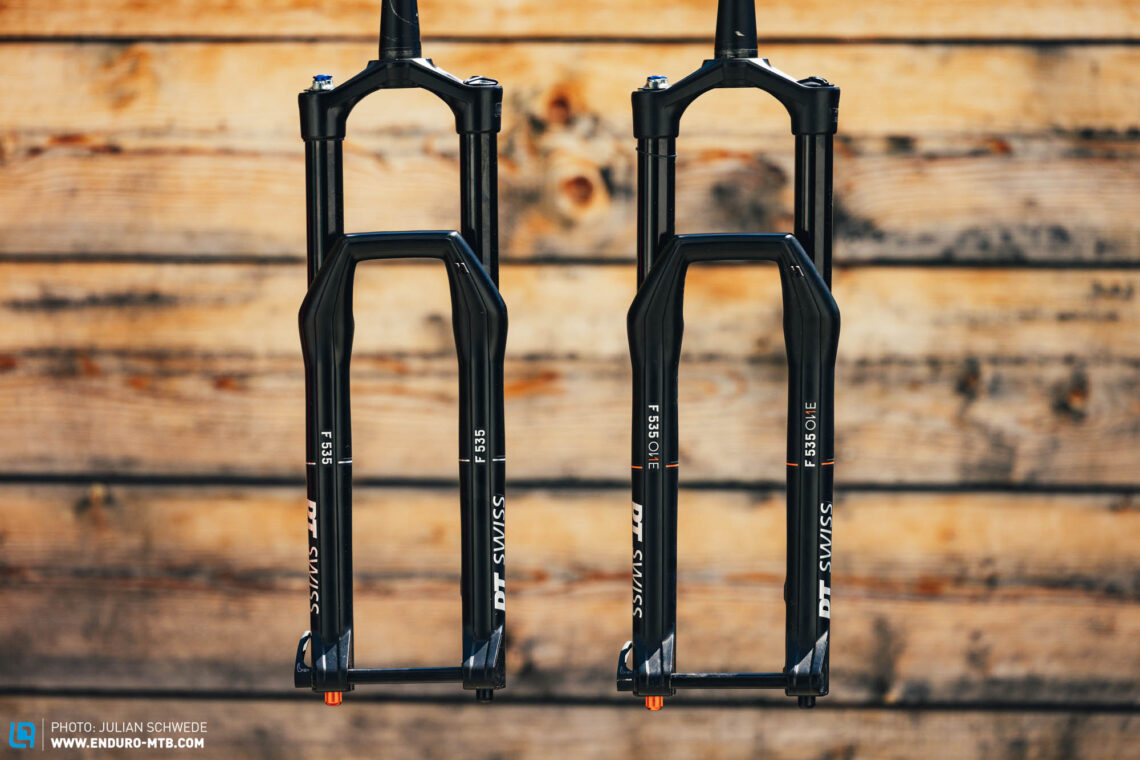First ride review: the new DT Swiss F 535 and F 535 ONE forks – Unequal twins
After five years in the making, DT Swiss present their new F 535 ONE fork, along with a lower-end and more affordable F 535 model. With 120–160 mm travel and some proven technology, DT Swiss are launching a new offensive on the fork market. We tested both forks to find out how the unequal twins perform on the trail.

DT Swiss F 535 ONE | 2,092 g (160 mm) | € 1149 | Manufacturer’s website
You’d be forgiven for being surprised by the news that DT Swiss have launched a new trail bike fork, even if you haven’t lived under a rock during the last few years. The Swiss brand, usually specialising in wheels, launched their first F 535 ONE fork 5 years ago, but we haven’t heard much about it since then and it has largely fallen off the radar. It’s a different story in the cross-country segment. Here, DT Swiss are fairly well-established, with some very successful World Cup teams relying on the Swiss brand’s suspension – World Cup overall titles included. To establish themselves on the longer-travel market, which is heavily dominated by RockShox and FOX, DT Swiss have dared to launch a new attack, introducing two new forks.
The flagship model, the F 535 ONE, comes in a new guise, though the internals remain unchanged, whereas the more affordable F 535 model has been developed from the ground up. Even though both forks look almost similar from the outside, the F 535 has to make do without some features of the F 535 ONE, which is reflected in the price. The cheaper F 535 goes for € 989, while you will have to fork out € 1,149 for the F 535 ONE. The F 535 tips the scales at 2,029 g (excluding the thru-axle), making it lighter than the more expensive F 535 ONE at 2,092 g, which is due to the less complex internals.
Both forks are available with travel ranging from 120 to 160 mm in 10 mm increments, and they’re exclusive to 29″ wheels.

Turning old into new – The DT Swiss F 535 and F 535 ONE forks in detail
The biggest novelty on the new forks are the adjustment dials, which have been put back on the outside. On the old F 535 ONE, the compression damping dial and the air valve were hidden under a black cap, which you had to remove with a Torx key before being able to make adjustments. It looked super clean, though it was rather impractical for the setup. On the new forks, the compression damping dials remain uncovered and the air valves are hidden under a conventional tool-free cover. Both forks offer 12 clicks of low-speed compression and 29 clicks of rebound, which allows for a finely tuned setup. There are various lockout stages, too, but more on that later.
While the internals of the F 535 ONE have remained the same, the F 535 is an entirely new fork. However, both forks share the new, optimised casting. They’re almost indistinguishable from the outside – only the addition of the small “ONE” lettering and the different lockout stages reveal which fork you’re dealing with.
Conveniently, the forks come with fenders as standard, which bolt on and fit perfectly into the recesses of the fork crowns. The fender is made of a stiff plastic, which makes a sturdy impression and doesn’t rattle on the trail. It could be a little longer, however, as we still got some mud on our faces when riding in wet conditions. The 5 mm Allen key hidden in the thru-axle is a nice touch. Incidentally, the thru-axle itself can be loosened without tools.
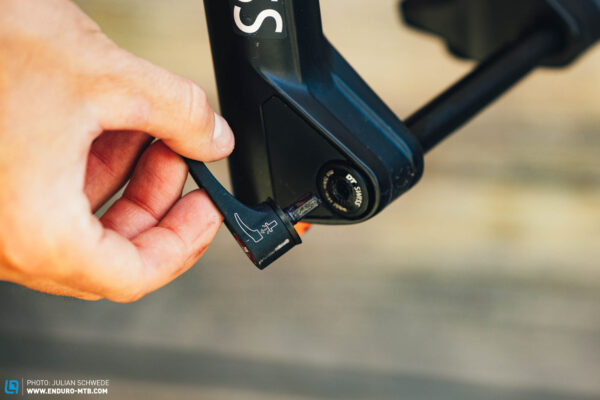
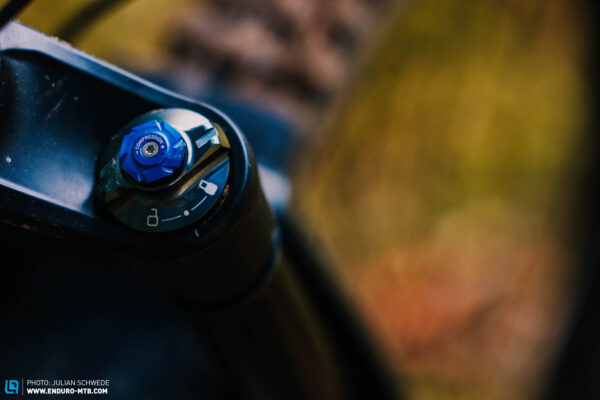
Air or coil shock, or why not both? The COILPAIR air spring in the DT Swiss F 535 ONE fork
Suspension forks with coils have the advantage of a more sensitive response, while air springs allow you to fine-tune the progression. But DT Swiss’ developers thought: why not just combine the two. So, they decided to combine an air spring with a small coil at the lower end. They’ve dubbed it COILPAIR, and it already featured in the old F 535 ONE. Unfortunately, the regular F 535 doesn’t have this, relying on a conventional air spring instead.
In the F 535 ONE model, the coil promises to offer an exceptionally sensitive response, and thereby mitigate the higher actuation force required of the air spring. And it does! However, the coil isn’t interchangeable, which could be a problem for particularly light or heavy riders. For ENDURO tester Felix, weighing in at 75 kg, it felt neither too soft nor too hard. The spring rate of the air spring can be adjusted with the help of volume spacers, as with other air sprung forks. Both forks come shipped with one spacer installed as standard. You only have to loosen a single nut on the air side to open it up and add or remove spacers as desired.
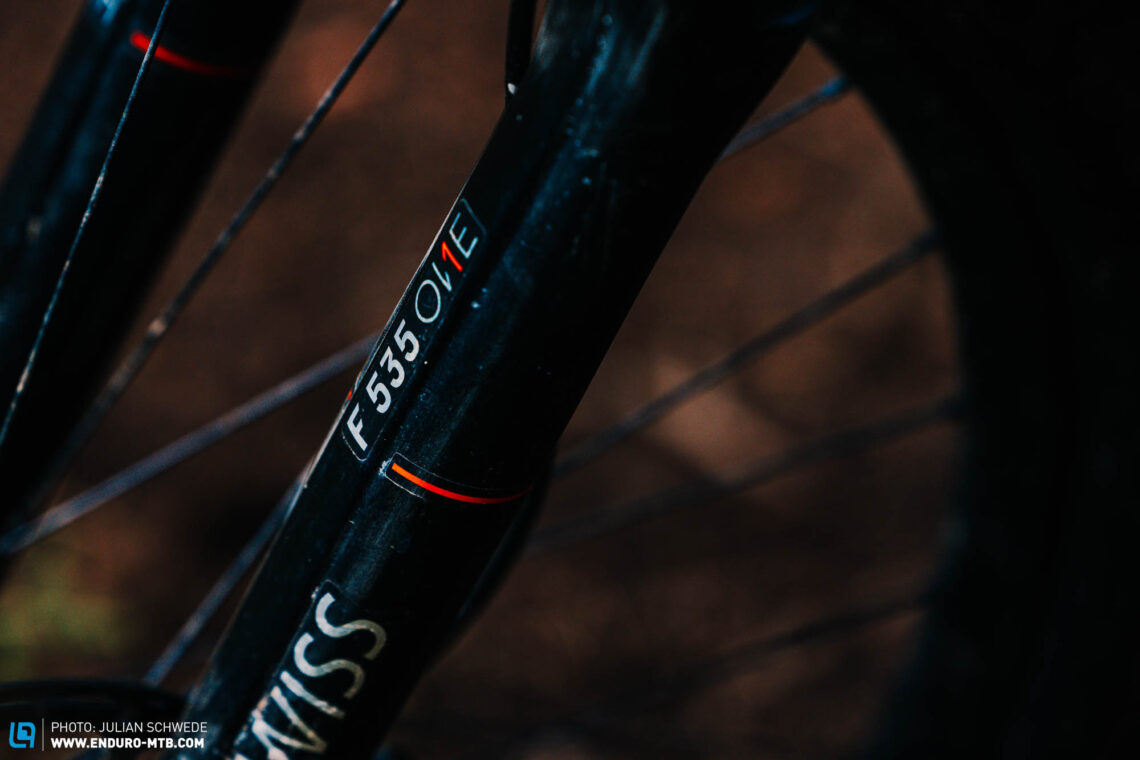
Plush, plusher, PLUSHPORT – The travel-dependent damping of the DT Swiss F 535 ONE
Up until now, damping as we know it has only taken the compression speed into account, passing oil through the high-speed or low-speed channels accordingly, and thereby controlling the damping. However, with the PLUSHPORT technology, DT Swiss also factor in the travel. The principle behind this is quite simple: the further the fork is compressed, the more the oil dampens the compression, increasing progressively.
The PLUSHPORT idea is based on the fact that different travel ranges require different damping characteristics. At the beginning of the travel, you typically require minimal damping, resulting in a plush and sensitive response. As the fork compresses, you need more damping to prevent it from bottoming out.
The concept is implemented via openings in the low-speed compression circuit, which get closed off progressively during compression. At the beginning of the travel, the low-speed channels are completely open, keeping the damping to a minimum. Mid-stroke, at about 30–50% travel, the holes are gradually closed off, which means that more oil must flow through the tighter high-speed compression channel, thereby increasing the damping. For the last 50% of the travel, the openings are completely closed, and all oil must pass through the high-speed channel, resulting in significantly higher damping. As a result, you get progressive damping. This should make itself felt on the trail, especially through compressions, providing a plush response off the top as well as plenty of support lower down in the travel.
However, the PLUSHPORT technology can only be found in the F 535 ONE fork, as the F 535 relies on conventional damping. The compression damping adjustment range for both forks is 12, well-defined clicks. If you turn the dial with your bare hands, it feels slightly uncomfortable and sharp-edged. The rebound at the bottom of the fork also offers 29 clicks of adjustment.
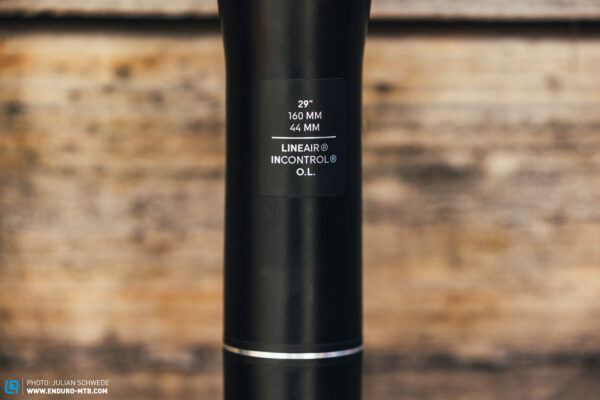
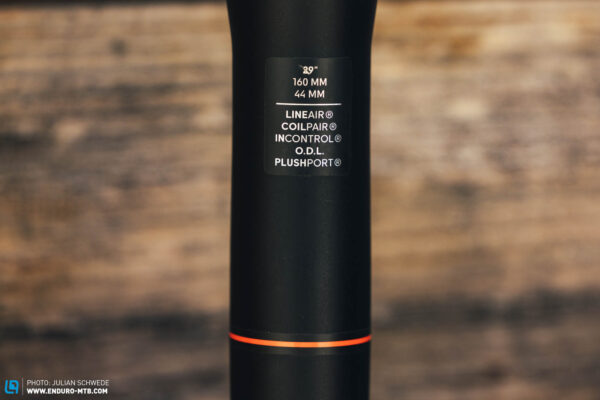
Open, Drive, Lock – The three INCONTROL modes of the DT Swiss suspension forks
Both the F 535 ONE and the F 535 forks have so-called INCONTROL lock-out modes on the damping side. While the F 535 ONE has three modes – Open, Drive, and Lock – the F 535 only lets you choose between Open and Lock.
In Open mode, the damper remains open, and the fork performs as usual. In the Drive mode of the F 535 ONE, the low-speed compression is completely closed, while the high-speed compression remains open. This is to firm up the fork while pedalling but still allowing it to absorb bumps from rocks and roots.
Lock mode is a complete lock-out. If you try to compress the fork with your arms while stationary in this mode, nothing happens. The forks have small safety valves that open at a certain pressure, allowing them to give way and thereby preventing the forks from getting damaged in Lock mode. However, we don’t see any point in having a full lock-out. The fork hardly bobs if you’re pedalling while seated anyway, and trail riders seldomly stand-up to sprint up a climb outside of racing.

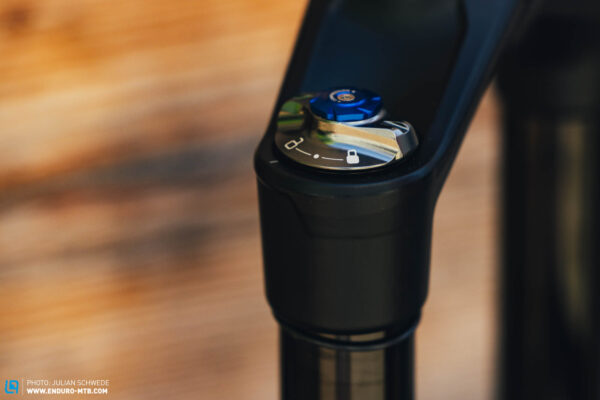
Unequal twins – The DT Swiss F 535 and F 535 ONE forks on the trail
To get an extensive first impression of the new forks, we didn’t just do a few runs with DT Swiss’ engineers on their jump-riddled home trails in Biel but also sent it on the trails surrounding Innsbruck for a few weeks thereafter. The forks had to prove themselves on natural trails full of roots, soft, slippery forest loam, and big drops.
Both forks are quick and easy to set up. The setup guide on DT Swiss’ website provides recommendations for the required air pressure as well as the corresponding compression and rebound clicks. However, there is no sticker on the fork, which is convenient when you don’t have internet access. For a rider weighing 75 kg, the setup guide recommended a pressure of 68 psi, along with 16 clicks of rebound, and fully opened compression damping. So those are the base settings that we started with.

You hardly notice either of the forks bobbing as you pedal up the climbs while seated, even in Open mode. If you switch to Drive mode on the F 535 ONE, even the slightest bobbing in the saddle is eliminated. It also provides plenty of support when standing up to pedal, though without letting the front wheel get hung up on obstacles. The Lock mode on both forks is best reserved for asphalt climbs or the occasional sprint to the finish against your friends. On rougher terrain, the Lock mode just punishes your hands. In Open mode, you already get a taste of the sensitivity of the F 535 ONE on the climbs. It absorbs almost all vibrations on rough gravel roads and stays glued to the ground on technical ascents.

After an appetiser of the fork sensitivity on the climb, you will be served the main course on the descent. The trail immediately feels like it’s been freshly shaped. The F 535 ONE feels very plush, completely absorbing small impacts and vibrations. It generates loads of grip, keeping the front wheel tracking even in wet conditions or on off camber sections riddled with roots. The F 535 can’t keep up with this level of performance. It responds noticeably worse, especially in direct comparison, as vibrations and small impacts are passed on to the rider a lot more clearly, causing the front wheel to lose grip.
When the hits get bigger, the PLUSHPORT damping of the F 535 ONE also leaves a positive impression. The fork feels like it’s got more travel than it has, even on the 160 mm version we tested. The ramp-up in the damping is smooth and creates a bottomless feeling, especially through big compressions.
With the compression damping fully open as recommended in the setup guide, the F 535 ONE fork could still do with a little more support when pumping through rollers or boosting off things. With one click more low-speed compression, the fork offered noticeably more support. Any more clicks than that quickly resulted in a harsh feeling. In general, every single click has a noticeable effect on the damping. With one volume spacer installed, which is how the forks are shipped, the air spring couldn’t quite keep up with the ramp-up offered by the PLUSHPORT damper. It let us rush through the last bit of travel on particularly big impacts. However, installing a second volume spacer quickly and easily remedied this, ensuring a smooth feeling low in the travel without letting the fork bottom out too harshly.
The lower end F 535 fork, on the other hand, needs more compression damping to offer enough support without the PLUSHPORT technology. Leaving the compression open as recommended lets it blow through the available travel when hitting compressions or trying to pump the bike. That said, we quickly got the problem under control with the help of more compression damping and a second volume spacer. Unfortunately, we couldn’t achieve the bottomless feeling of the F 535 ONE no matter how much we fiddled with the settings.


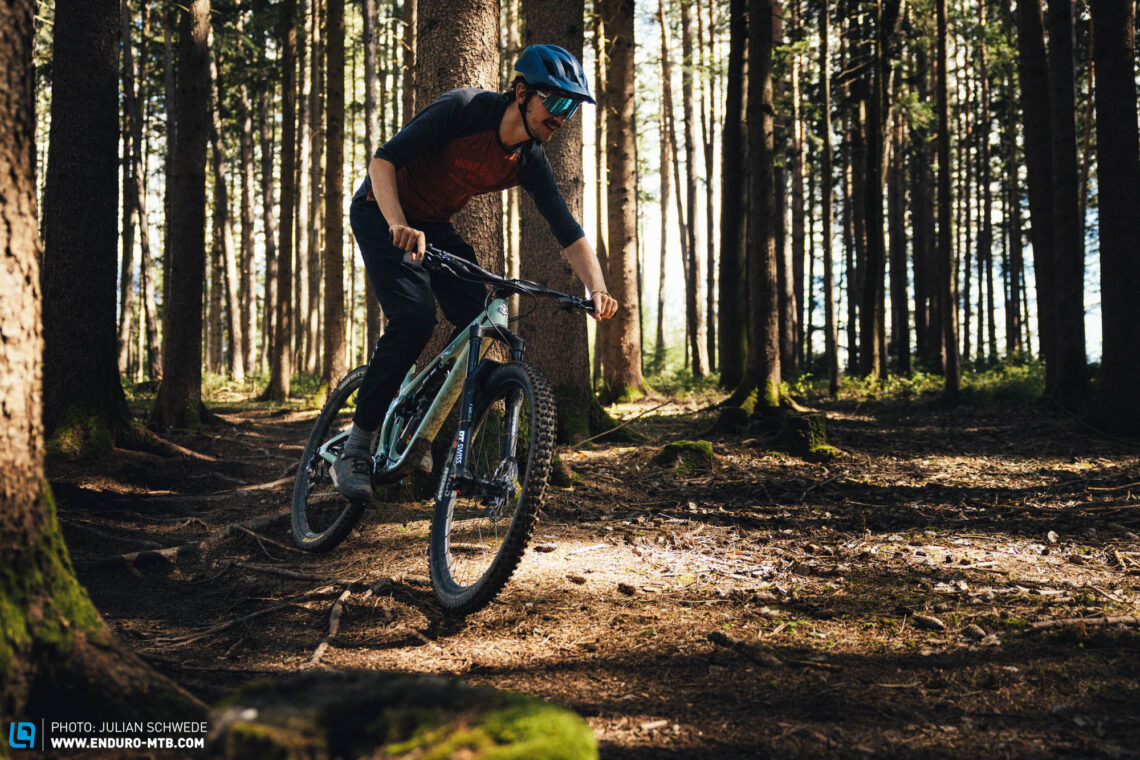
Who is the DT Swiss F 535 ONE for? Who is better off with the F 535?
Neither of the new forks cater to setup nerds but rather to the “set and forget” crowd. Demanding riders will miss the lack of high-speed compression adjustability. Because of its plush response, however, the F 535 ONE fork is a great option for riders with sensitive fingers and forearms. Advanced riders will benefit from the support offered by the PLUSHPORT system when blasting through compressions or generating speed through rollers. If you can do without the plush ride of the COILPAIR spring and are looking for a decent entry-level fork that doesn’t require you to fiddle with the setup, the F 535 is a solid contender, though the better F 535 ONE costs just € 160 more.
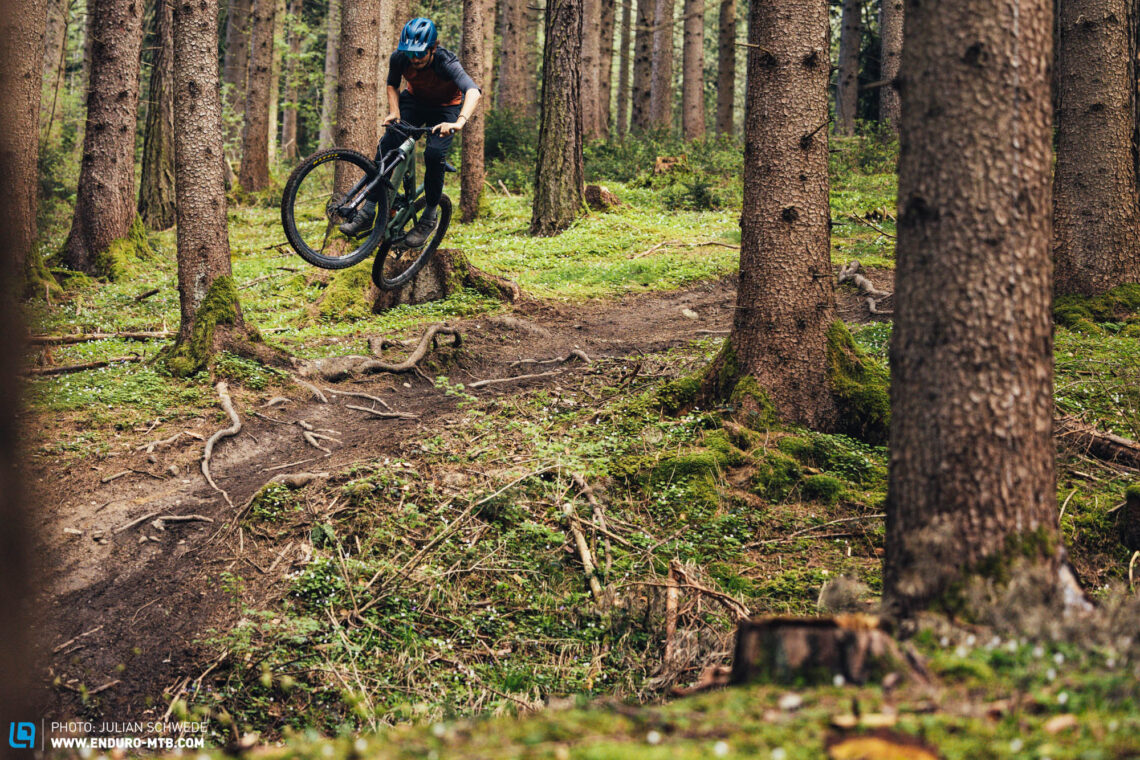
Conclusion on the DT Swiss F 535 and F 535 ONE forks
While the 2023 DT Swiss F 535 ONE fork has a new look, the internals remain unchanged. The COILPAIR spring technology offers a very sensitive and plush response while the PLUSHPORT system results in progressive damping. As such, you get a masterful combination of small bump sensitivity and mid-stroke support. The new entry-level F 535 is a solid performer, too, but it can’t keep up with the sensitivity and damping performance of its more expensive counterpart. In this case, it’s worth forking out an extra € 160 for the flagship model.
Tops
- small bump sensitivity of the F 535 ONE
- progressive damping of the F 535 ONE creates a bottomless feeling
- no-fuss setup
Flops
- base F 535 can’t keep up in terms of damping and sensitivity.
For more information, visit dtswiss.com
